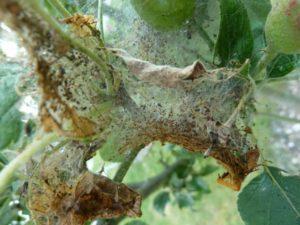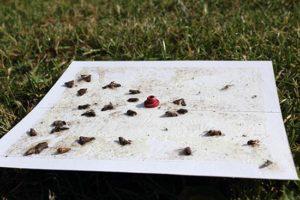Apple moth: an inconspicuous pest of the whole garden
One of the worst pests of horticultural crops is the mining apple moth, the offspring of which infects a large number of leaves on fruit trees. The fight against it is carried out by chemical and mechanical methods.
Content
What does an apple moth look like (photo)
Description of the mining apple moth
Name: apple moth
Latin: Hyponomeuta malinellaClass: Insects - Insecta
Squad: Lepidoptera - Lepidoptera
Family: Ermine moths - Yponomeutidae
 | Habitats: | garden |
 | Dangerous for: | fruit trees |
 | Means of destruction: | biological complexes, pheromone traps. |
Apple moth is from the family of ermine moths. The body of the insect is covered with a chitinous membrane that protects against cold, 12-15 mm long.
The moth has 2 pairs of wings, the front ones are whitish with black patches, the back ones are gray with a frame.
The apple moth lives in Europe - in Sweden, Finland, Britain, in North America - in the USA and Canada, in Russia - in Siberia. Most often, it parasitizes on an apple tree, but it can affect various fruit trees - plum, cherry, pear.
Stages of development
Butterflies appear at the beginning of summer, in June. At first they hide in the grass, after they get stronger, they sit on the inside of the leaf, and in the evening they begin to fly actively. After mating, females lay their eggs mainly on the bark of apple trees.
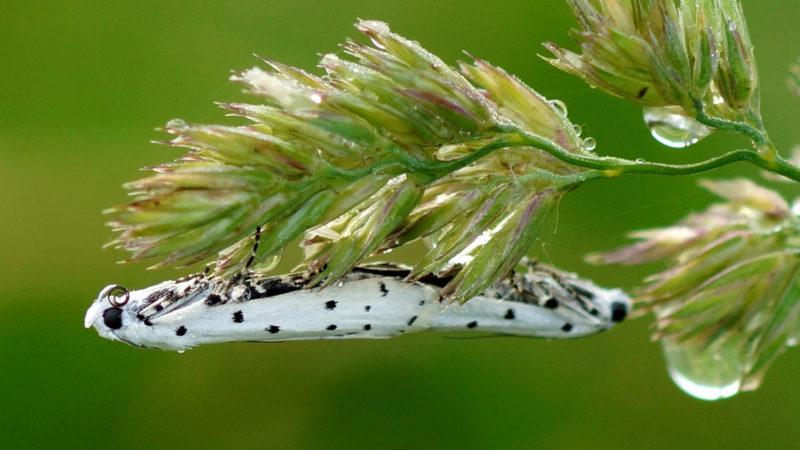
Butterfly apple moth.

Moth caterpillar.
Eggs covered with mucus, which forms a kind of shield, each heap consists of 15-50 eggs. A month later, larvae appear from them.
Color caterpillars - light beige, black head and legs, dark spots with black dots on the back. They remain to winter under the shield, feeding on the bark and shell of the egg. In the spring, they settle on young leaves of an apple tree, gnawing them at the base of the leaf and penetrating inside, the leaves then darken, dry and fall off.
Coming to the outer surface of the leaves, the caterpillars cover them with a secret similar to a cobweb. In early May, caterpillars settle on the tops of branches, build nests from cobwebs on them, their number can reach one thousand. In the second half of May, the pests pupate, white cocoons are located in groups in the axils of the branches.
The process of turning a pupa into an adult insect - an imago is 12-14 days, butterflies appear 30-45 days after the flowering of the apple tree. After leaving the cocoon, the females begin to actively mate and lay eggs a week later. The summer period continues until the end of summer.
What is dangerous apple moth
Apple moth larvae are able to eat a large amount of young greenery on fruit trees, which disrupts photosynthesis in the leaves. This leads to a lack of nutrients required for the formation of ovaries.
With a strong defeat, the tree does not bloom and does not bear fruit. Also, these pests are dangerous because, by weakening the plant, they deprive it of frost resistance, and in severe cold it can die.
What harms a butterfly or a caterpillar
An adult insect indirectly harms trees - females lay eggs after mating, from which larvae subsequently emerge. Damage is caused by caterpillars, they feed on juices and leaves of apple trees, which is why young shoots and ovaries die.
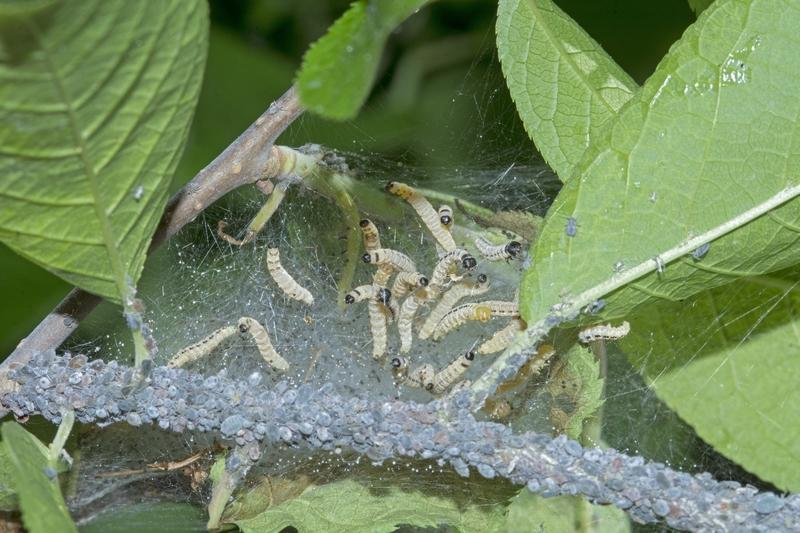
Apple moth caterpillars.
Methods of dealing with apple moth
To protect fruit trees and preserve the crop, it is necessary to prevent the emergence and spread of this dangerous pest, and measures should be started already in early spring. Both folk remedies and chemical preparations are used. During the period of bud formation, they are sprayed for the first time, the second - after flowering. Repeat the treatment in late August - early September.
Treatment with biological complexes
Carrying out processing biological complexes is a more harmless way, but, compared with chemical insecticides, not as effective. Trees with a small degree of fruit moth infection are treated with these agents and used for preventive purposes.
These include:
- entobacterin;
- "spark-bio";
- bitoxybacillin.
Preparations provide for the preparation of a solution from a dry mixture. Spraying with them is carried out in the spring, when the air warms up to + 10 ... 15 ° С. Before the beginning of the flowering period, you can process several times. To prevent the appearance of apple moth, spraying with biological solutions is done in the middle and end of summer.
Processing with chemicals
With severe damage to fruit trees by larvae, chemical agents are used, they have a more effective and lasting effect, but are toxic.
These are: Inta Vir, Fozolone, Kinmiks. They must be used as indicated in the instructions, observing the dosage and using protective equipment.
Folk remedies against moths
Folk remedies for apple moth treatment are considered safe for plants and humans. But they are used in cases of small infection of apple trees with pests and for prevention. But it must be taken into account that over time, the fruit moth develops immunity to such means, and they cease to act.
Bitter pepper
To destroy the larvae, an infusion of hot pepper is used. It is prepared as follows: 1 pods of pepper are placed in 10 liter of water, boiled for an hour in a tightly closed saucepan. Then cool and insist for a day. Before spraying, a solution prepared from laundry soap (30-50g) is added so that the tincture stays longer on the crown and bark of the tree.

Pepper tincture.
Tobacco
Tobacco tincture is used to scare apple moths from fruit trees. To prepare it, take 500-700 grams of tobacco, pour 8-10 liters of boiling water and let it brew for three days. Then filter, add a soapy solution, and the tincture is ready. Branches are treated with tobacco infusion until greenery appears.
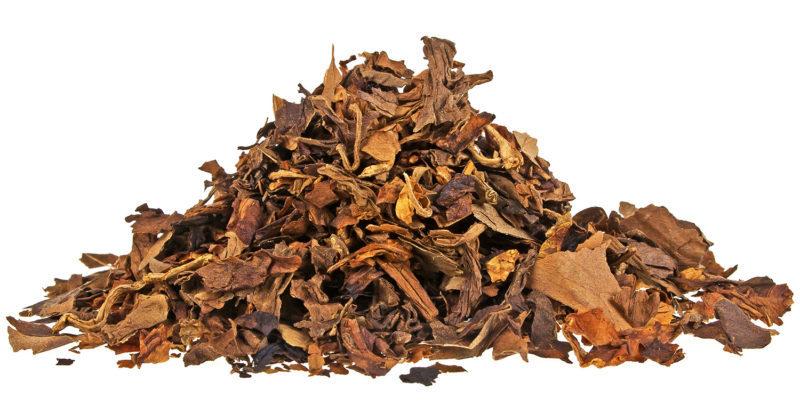
Tobacco tincture repels moths.
Mechanical methods
Mechanical methods can reduce the degree of infection of fruit crops with apple moth. When visually detected, cocoons and nests are collected and destroyed (burned).
At the end of the autumn period, the area is freed from fallen leaves. Also, for preventive purposes, they dig up the soil near the trees. Before the start of the growing season, sanitary pruning of the branches is performed, the trunk and main branches are whitewashed.
Used to kill males pheromone traps. This is a device with a sticky bottom, inside which a capsule with synthetic pheromones is placed. Butterfly males fly by smell, stick to the adhesive base and remain trapped. Females are deprived of mating and cannot give offspring. The action of the capsule is designed for 1,5-2 months, one trap is enough for one tree.
To catch butterflies, they also use adhesive tapes hung on branches, and for caterpillars - glued to the trunk.
Natural enemies of the apple moth
The natural enemies of the apple moth are parasitic insects such as braconid wasps and tahini flies. They lay their eggs inside apple moth eggs or in the body of an adult insect. For food, parasitic larvae begin to use the tissues and organs of the host, and he dies.
Birds help to destroy the butterfly population, so birdhouses are installed in garden plots to attract them.
Prevention of the appearance
To prevent the appearance of apple moth in gardens, you need:
- Regularly inspect the foliage and bark of fruit trees for the presence of eggs and caterpillars.
- For preventive purposes, spray plants
- biological preparations and folk remedies.
- If a small number of pests are found on one tree, manually collect and destroy, process, and prevent further spread to other plants.
- Perform treatment of the area where the affected trees are located.
- Remove fallen leaves from the site promptly.
Apple moth is an insect pest of fruit trees that can destroy not only the crop, but also the plant itself. Get rid of it by spraying trees with pesticides and biological products. Auxiliary measures are the processing of folk remedies and manual collection, followed by the destruction of moth larvae and nests.
Previous
